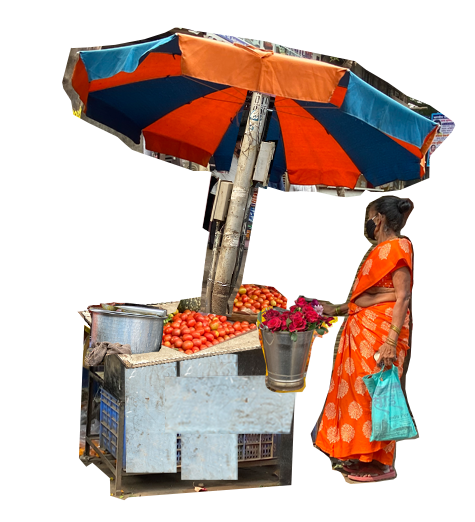
Research & Documentation.
Self-Initiated. 2021.
Furniture:
(noun)
1. the movable articles that are used to make a room or building suitable for living or working in, such as tables, chairs, or desks.
2. the small accessories or fittings that are required for a particular task or function: door furniture.
Street Furniture:
(noun)
1. is a collective term (used in the United States, [1]United Kingdom,[2] Australia[3] and Canada[4][5]) for objects and pieces of equipment installed along streets and roads for various purposes.
Born as hybrid elements, there exists an entire class of furniture that float somewhere between these two categories. These pieces are so widespread that at most places they’re the visually dominating parts of the street and some argue they dictate the character of the city. as mentioned later.

In his essay titled ‘Kinetic City’, Rahul Mehrotra talks about the ephemeral city and the culture, socio-economics and politics surrounding these elements and their being the primary contributors to the image and character of the city.

Another significant study/exhibition within this sphere was Transactional Objects by Rupali Gupte & Prasad Shetty (2015) Taking notes from the city of Mumbai, the forces which go into the making of these objects were listed and mapped. An extensive study of these objects and their forms and functions were conducted. A whole new set of objects were designed and exhibited based on the categorizations made during the research. What resulted was a speculation of what these objects could evolve into with minor shifts in the notions of the form-function relationship and nuanced differences in classical tropes.
The initial photographs in the series have no text associated with them in order to permit the viewer the freedom to form their own associations and interpretations.


Visual Study/ Ongoing Research & Documentation. Self-Initiated. 2021.
Furniture:
(noun)
1. the movable articles that are used to make a room or building suitable for living or working in, such as tables, chairs, or desks.
2. the small accessories or fittings that are required for a particular task or function: door furniture.
Street Furniture:
(noun)
1. is a collective term (used in the United States, [1]United Kingdom,[2] Australia[3] and Canada[4][5]) for objects and pieces of equipment installed along streets and roads for various purposes.
Born as hybrid elements, there exists an entire class of furniture that float somewhere between these two categories. These pieces are so widespread that at most places they’re the visually dominating parts of the street and some argue they dictate the character of the city. as mentioned later.

Born as hybrid elements, there exists an entire class of furniture that float somewhere between these two categories. These pieces are so widespread that at most places they’re the visually dominating parts of the street and some argue they dictate the character of the city. as mentioned later.

In his essay titled ‘Kinetic City’, Rahul Mehrotra talks about the ephemeral city and the culture, socio-economics and politics surrounding these elements and their being the primary contributors to the image and character of the city.
Another significant study/exhibition within this sphere was Transactional Objects by Rupali Gupte & Prasad Shetty (2015) Taking notes from the city of Mumbai, the forces which go into the making of these objects were listed and mapped. An extensive study of these objects and their forms and functions were conducted. A whole new set of objects were designed and exhibited based on the categorizations made during the research. What resulted was a speculation of what these objects could evolve into with minor shifts in the notions of the form-function relationship and nuanced differences in classical tropes.
The initial photographs in the series have no text associated with them in order to permit the viewer the freedom to form their own associations and interpretations.